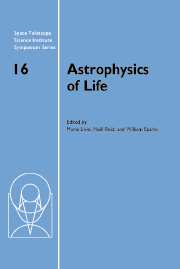 Astrophysics of Life
Astrophysics of Life Published online by Cambridge University Press: 29 August 2009
A planetary system may undergo significant radial rearrangement during the early part of its lifetime. Planet migration can come about through interaction with the surrounding planetesimal disk and the gas disk—while the latter is still present—as well as through planet-planet interactions. We review the major proposed migration mechanisms in the context of the planet formation process, in our Solar System as well as in others.
Introduction
The word planet is derived from the Greek word “planetes,” meaning wandering star. Geocentric views of the Universe held sway until the Middle Ages, when Copernicus and Kepler developed a better phenomenological explanation of planetary wanderings, which with small modifications has withstood the test of time. Kepler's first law of planetary motion states that planets travel along elliptical paths with one focus at the Sun. Thus, although planets wander about the sky, in this model their orbits remain fixed and they do not migrate. In his physical model of the Solar System, Newton theorized that planets gradually altered one another's orbits, and he felt compelled to hypothesize occasional divine intervention to keep planetary trajectories well-behaved over long periods of time. In the early 1800s, Poisson pointed out that planetary-type perturbations cannot produce secular changes in orbital elements to second order in the mass ratio of the planets to the Sun, but Poincare's work towards the end of the 19th century suggests that the Solar System may be chaotic.
To save this book to your Kindle, first ensure [email protected] is added to your Approved Personal Document E-mail List under your Personal Document Settings on the Manage Your Content and Devices page of your Amazon account. Then enter the ‘name’ part of your Kindle email address below. Find out more about saving to your Kindle.
Note you can select to save to either the @free.kindle.com or @kindle.com variations. ‘@free.kindle.com’ emails are free but can only be saved to your device when it is connected to wi-fi. ‘@kindle.com’ emails can be delivered even when you are not connected to wi-fi, but note that service fees apply.
Find out more about the Kindle Personal Document Service.
To save content items to your account, please confirm that you agree to abide by our usage policies. If this is the first time you use this feature, you will be asked to authorise Cambridge Core to connect with your account. Find out more about saving content to Dropbox.
To save content items to your account, please confirm that you agree to abide by our usage policies. If this is the first time you use this feature, you will be asked to authorise Cambridge Core to connect with your account. Find out more about saving content to Google Drive.